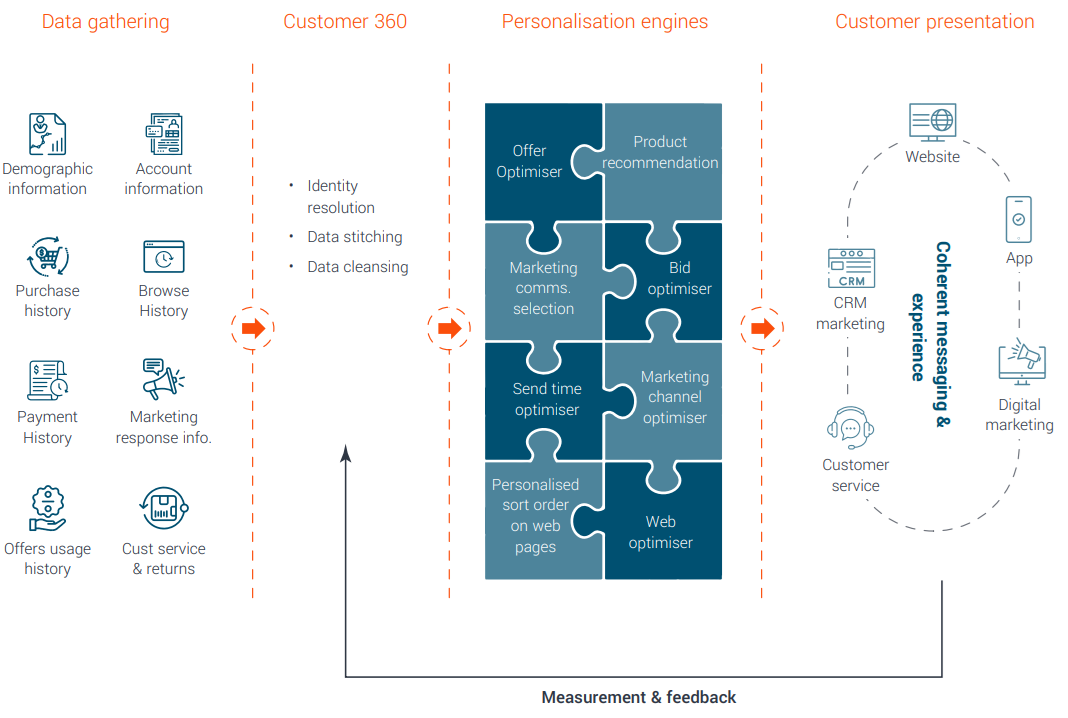Personalisation in digital retail
Data serves as the fundamental building block of any robust personalisation programme. However, the success of such a programme is tied to the organisation’s data strategy.
Introduction
Personalisation is a key focus area for e-commerce retailers to go beyond the prevalent practice of engaging in bidding wars to get the customer’s attention. In the place of bidding wars to purchase online retail space, e-commerce brands can instead nurture the relationship with each and every customer, making it unique to their individual profile, shopping and communication preferences, and purchase history. Additionally, the widespread failure of many e-commerce brands to give a personalisation strategy the attention and resources that it really requires to be successful represents an elusive business opportunity for the brands that are ready and willing to do so.
The findings from a Salesforce study highlight how personalisation can be the key customer engagement and sales driver for e-commerce brands:
- More than two-thirds of customers now expect companies to understand their unique needs and expectations.
- Three in five customers anticipate that companies will proactively meet their needs.
- Over 50% of customers feel that they are just a customer ID to their preferred companies. This underscores an opportunity that proactive digital retailers can take advantage of.
The building blocks of a successful personalisation strategy
Data serves as the fundamental building block of any robust personalisation programme. However, the success of such a programme is tied to the organisation’s data strategy. In digital retail, where companies interact with customers across a wide range of channels, including websites, apps, contact centres, and other options, it is essential that interactions are orchestrated seamlessly. Achieving an end-to-end personalised customer experience hinges on maintaining coherence and consistency across these diverse touch points. While it may be relatively simpler to execute localised personalisation for individual channels and tactics, the true measure of success lies in how these personalised elements converge to create a unified customer experience. The lack of a synchronised experience can backfire and end up confusing the customer. Therefore, it requires a holistic and cross-functional approach to ensure an impactful personalised customer experience.
A typical personalisation programme can be divided into four stages.
- The data driving personalisation: The cornerstone of a successful personalisation strategy is precise, comprehensive, quality data. The principle is straightforward: the more we understand the customer, the more effectively we can tailor their experience. Consequently, the initial component of an effective personalisation strategy revolves around collecting data from a wide range of sources, including on-site interactions on websites or apps, purchase history, payment behaviour, contact centre interactions, marketing communications, survey responses etc. These disparate streams of data must be seamlessly stitched together at a customer level to construct a 360 view of the customer. This has become increasingly complex due to recent regulations, such as GDPR, and developments like the deprecation of third-party cookies in the digital data landscape. From our experience at EXL with diverse clientele, we have observed that digital tag management is an area where many organisations struggle to install robust governance and management processes. The consequence of these struggles is a substandard ability to gather, store, and interpret first-party data. The walled nature of digital marketing platforms can make data management processes more complex than they need to be, and generate new challenges too. Collecting an accurate 360 view of the customer has become a major hurdle. Many organisations are resorting to customer segment level approximations to bridge the gaps in their understanding.
- Smart personalisation engine: This second component serves as the brain behind the entire operation. After the data has been gathered, stitched, and cleansed, it enters a chain of decision engines where the magic of personalisation unfolds. This is the stage where all decision making takes place, and the next steps for various interfaces are evaluated, scored, compared, and determined. Different experiences and outcomes for each customer are carefully designed and reviewed. With automation, big data, and machine learning technologies, online retailers can carry out a personalised experience for each customer. For instance, this could include personalised recommendations of products for purchase sent via the customer’s preferred communication channel within a specific monetary range based on their previous purchase history.
- Effective presentation: Once the product offer and method of presentation is chosen, the presentation experience should be designed for an optimal user experience to maximise conversion rates. This presentation extends to ease of offer analysis by the customer and a seamless, fast, secure payment process.
- Robust measurement and feedback: The success of a personalisation programme also hinges on effective measurement. The measurement framework should enable insights across various levels of the programme. It should be able to provide a top-level view for senior leaders on overall programme performance, as well as presenting granular insights across various parameters to regularly enhance the approach. We have seen organisations leaning towards a unified measurement framework, in the form of a top-down view solution. This approach enables organisations to better understand spend allocation on a macro level. Additionally, it can be supported by a bottoms-up attribution solution at the same time to understand performance at the micro level. In our experience at EXL, a multi-touch feedback strategy is effective – better still if this is also personalised to the customer’s communication preferences
The various parts of a successful personalisation programme can be summarised in the following diagram:

Conclusion
A McKinsey study revealed that companies excelling at personalisation are likely to generate 40% more revenue from these activities. Therefore, digital retailers cannot afford to serve their customers with a one-size-fits-all approach. Personalisation is now the key to revenue growth and enhancing customer loyalty.
At EXL, we have helped many e-commerce retailers embed high-performing personalisation strategies for unprecedented results. Please reach out to us to learn about our success stories and how we can help your ecommerce brand to drive new levels of customer engagement and sales through personalisation.
References
1. What Are Customer Expectations, and How Have They Changed? - Salesforce.com
2. The value of getting personalization right—or wrong—is multiplying | McKinsey
Written by:
Aditya Kalia
SAVP, Analytics
